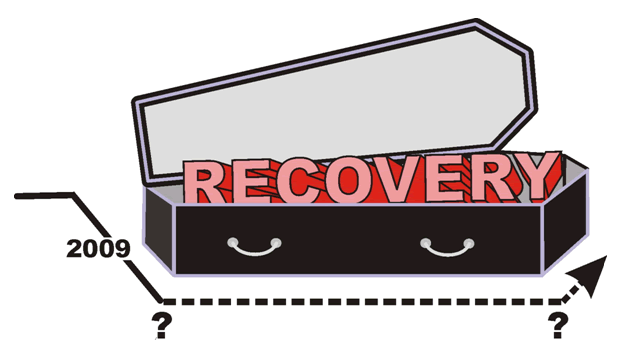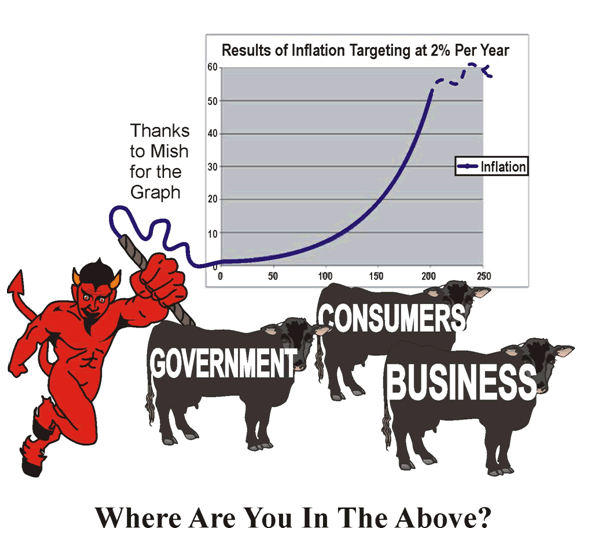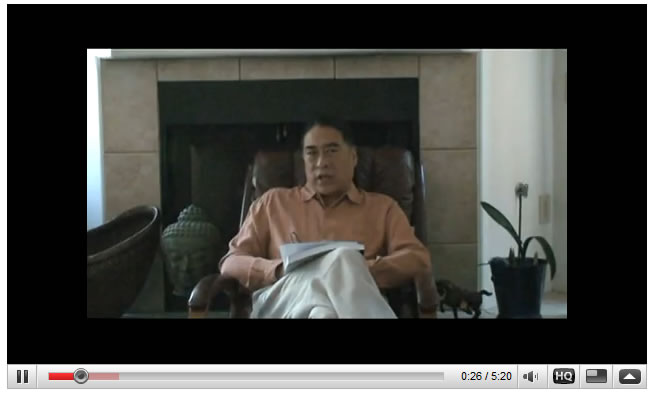The Coffin Shaped Economic Recovery
Economics / Recession 2008 - 2010 Sep 29, 2009 - 04:37 AM GMTBy: Darryl_R_Schoon
 While often wrong, Bernanke is right about the recession. It’s almost over. But a depression is about to replace it.
While often wrong, Bernanke is right about the recession. It’s almost over. But a depression is about to replace it.
There has been much discussion about this recovery, whether it will be a “U”, “V” or a “W” shaped recovery. The answer is none of the above. It is going to be “C -shaped” recovery, but not as in the letter “C” but as in coffin.

The Coffin-Shaped Recovery
It would be a miracle if trillions of dollars of debt could be wiped out with one stock market crash and be succeeded by a new bull market driven by another large offering of credit by the Fed.
But such a central bank-engineered miracle today is impossible. Capitalism’s natural cycles derive from central banker’s unnatural infusion of credit into previously free markets. The subsequent distortion causes market demand to expand (which everybody loves) only to be followed by the inevitable contraction—which everybody hates.
Usually, central banks wait until previous levels of excess credit have been absorbed in an economic downturn before embarking on a fresh round of credit creation. This time, however, it is different.
This time, the cumulative buildup of debt over previous cycles where contractions were cut short to minimize economic pain and attendant political consequences is now so large that any contraction is sufficient to bring down the extraordinary backlog of debt built up over previous cycles.
The current contraction is more than sufficient to do so as it is more severe than any downturn since the 1930s; and despite the frantic attempts of central banks to contain the cumulative forces unleashed by previous cycles of credit and debt, the enormous but fragile paper-based economy built by central bankers’ paper money is now collapsing.
To hopefully prevent the collapse from reaching its catastrophic end, central bankers have now intervened far earlier and with far more credit hoping to prevent the day of reckoning, a reckoning soon to be evidenced by an historic deflationary depression that will wipe out all accumulated unpayble debts, albeit at the cost of a functioning world economy.
Such is Ben Bernanke’s considerable task. Despite his outwardly positive demeanor, Bernanke is well aware that his desperate gamble hasn’t worked.
In these times, the last thing you want to be is Ben Bernanke’s sphincter.
(note: Martha declined to produce my relevant cartoon)
KEYNESIAN COPS, FRIEDMAN’S FOLLIES
AND THE FLAWED THEORY BEHIND THE RECOVERY
The current chairman of the US central bank is Ben Bernanke, a self-described student of the Great Depression; but, learning is limited by what is taught and regarding the Great Depression, Bernanke’s teacher unfortunately was Milton Friedman.
The reason why central bankers (and Ben Bernanke in particular) are flooding the global economy with money, i.e. borrowed, printed, or monetized out of thin air with such abandon (who would have thought bankers could act with abandon except, of course, when believing risk is non-existent and they’re betting someone else’s money), is because of Milton Friedman’s theory, to wit that economic contractions can be reversed by sufficient monetary expansion.
Laid bare, Freidman’s theory is another iteration of the Keynesian belief in the power of government intervention, albeit an intervention cloaked in Friedman’s more palatable—at least to those on the right—conservative garb.
Friedman argued that if the Fed had aggressively expanded the money supply in the 1930s, it would have then counteracted deflationary forces and prevented the Great Depression, an argument unfortunately as flawed as another of Friedman’s pet theories, i.e. that floating exchange rates would naturally over time bring global trade deficits into balance.
Note: When exchange rates were allowed to float in 1974 as encouraged by Friedman who also encouraged Nixon to abandon the gold standard in 1971, the US had a positive balance of trade. Thirty five years later, the US trade deficit is well over $800 billion and is growing over $20 billion each month (Hey, Milton, how much more time will it take to balance the trade deficit?).
Professor Antal Fekete warned several years ago that Friedman would someday be proved wrong and that we would collectively suffer the consequences; and, that just as during the Great Depression when banks hoarded the government’s cheap money instead of lending it, they would do so again when Friedman’s theory of monetary expansion was tried during another contraction.
Professor Fekete’s warnings have now come true. Today, US bank lending growth has entered negative territory at the same time cash reserves at US banks increased by 1,460 %.
Frank Shostak in Does A Liquidity Trap Pose A Threat, 9/23/09, on mises.org writes:
The latest data for lending in the eurozone the United Kingdom, and the United States display a visible weakening. In the eurozone, the yearly rate of growth of bank lending to the private sector fell to 0.6% this July from 9.3% in July last year. In the United Kingdom, the yearly rate of growth of lending to the private sector fell to 2.2% in July 2009 from 10.1% in July 2008. In the United States, the rate of growth of lending plunged to minus 3.8% in August 2009 from a positive figure of 8.6% in August 2008…At the end of July this year, [however], US banks were sitting on $729 billion of cash against $1.9 billion in July last year.
Does a Liquidity Trap Pose a Threat Economic Recovery?- [bracketed words, mine]
Friedman’s theory is flawed and as suspect as the paper money Friedman and Keynes both promoted. Central banks can print all the money they want but that will not necessarily increase the money supply as central bankers are discovering.
Severe monetary contractions that cause deflationary depressions are so powerful they, like monetary black holes, can destroy money faster than central banks can create it.
The on-going monetary contraction is now clearly evident. Ambrose Evans-Pritchard, columnist for The Telegraph UK, points out the glaring truth that Bernanke and most of his paper-weight brethren would like to avoid:
The US money supply has experienced the sharpest contraction in modern history, heightening the risk of a Wall Street crunch and a severe economic slowdown in coming months... the M3 ''broad money" aggregates fell by almost $50bn (£26.8bn) in July, the biggest one-month fall since modern records began in 1959.
“Monthly data for July show that the broad money growth has almost collapsed," said Gabriel Stein, the group's leading monetary economist.
On a three-month basis, the M3 growth rate has fallen from almost 19pc earlier this year to just 2.1pc (annualised) for the period from May to July. This is below the rate of inflation, implying a shrinkage in real terms.
The growth in bank loans has turned negative to a halt since March.... shifts in M3 are a lead indicator of asset prices moves, typically six months or so ahead. If so, the latest collapse points to a grim autumn for Wall Street and for the American property market. As a rule of thumb, the data gives a one-year advance signal on economic growth, and a two-year signal on future inflation.
http://www.telegraph.co.uk/finance/economics/2795017/Sharp-US-money-supply-contraction-points-to-Wall-Street-crunch-ahead.html
This is not your mother’s contraction. Instead, this is the mother of all contractions, a contraction far greater than even that which sent the world into the Great Depression in the 1930s.
This time, the amounts owed are exponentially greater than what was owed in the 1930s; and, the greater the debts, the farther the fall. Debt does not just disappear without consequences, nor can it be outrun, sic outgrown, as economists are desperately hoping, especially today when economies are contracting, not expanding.
Economic contractions cannot be reversed by expanding the money supply any more than wishful thinking by itself will change the world. Despite the best efforts of central bankers like Ben Bernanke, Friedman’s flawed theory cannot save the world from what is now about to happen—the mother of all depressions that may be capitalism’s last.
Keynes and Friedman, both brilliant, were both believers in paper money. Paper money has many powers, not the least of which is the power to mislead and delude.
Milton Friedman thought a lot
Of paper money and more
Like Keynes and others who thought the same
Milton showed gold the door
And now our gold is spent and gone
And so is Milton too
And now we’re left bereft and broke
Not knowing what to do
But Ben Bernanke’s at the helm
Of the sinking ship we’re on
And soon like Milton and our gold
We, too, will soon be gone
So let’s make a toast while we’re still here
To those who caused our ruin
To those convinced that they were right
But didn’t know what they were doing
WHO BENEFITS FROM THE FRAUD OF PAPER MONEY
The substitution of paper money for gold and silver has always been imposed by those who govern upon those governed; and, in the US it was done so illegally. The US Constitution explicitly defines the US dollar in silver, not paper money. The current regime of fiat money in the US is not only a monetary abomination, it is de jure unconstitutional.
The imposition of fiat money in the US was done without the consent of the governed. However, those who govern approved it. This is because the advantages of paper money accrue to those who rule; and it is in their interests, not society’s, that paper fiat money becomes the coin of the realm.
The disadvantages of paper money are borne by society-at-large, i.e. entrepreneurs, workers, businesses, retirees, savers, etc. who pay retail for the credit dispensed wholesale to those better connected, e.g. are you able to leverage your investments 50:1 as can JP Morgan Chase, Goldman Sachs, etc.; and, can you to carry your underwater investments at full book value and borrow against them as it does Wall Street? And were you bailed out last year as were the banks?
I have always been amazed at those who identify with a system that primarily serves the needs of others and only incidentally theirs. I can only conclude that such identification is symptomatic of low self-esteem, as self-interest alone would dictate otherwise.
We are now headed towards a rendering so extreme that such divisions will become clear and perhaps the many will finally cease identifying with a system that benefits the few closest to the fountainhead of credit while penalizing the many farther downstream which usually includes them.
Modern economics is a sophisticated Ponzi-scheme cross-pollinated with a shell game designed for the advantage of government, banks and those at the front of the line wherein money is created out of thin air to be loaned to others who will in the end be indebted beyond their means to repay and whose economic futures will be destroyed by the inevitable confluence of the bankers’ compounding interest and their constant inflation of the money supply.

If you doubt this is so, an article The Event by Eric Andrews, is a must read, especially the areas directly concerned with money and its creation. If you already believe this is so, Eric Andrew’s article is even more important. Clear, concise, and conclusive, it points out the inherent problems with our debt-based system of paper money, a system that contains its own seeds of destruction, seeds which are now flowering, www.financialsense.com/...
Andrews also points out where we are and perhaps headed without guessing when we will arrive. We face a minefield of possible scenarios as deflation, inflation, hyperinflation, or a combination thereof may soon be in our future as the bankers’ paper money is now about to self-destruct.
THE BARRICKADE TO GOLD CRUMBLES
We are in the final stage of the paper-boys’ efforts to preserve their crumbling fiefdoms against gold’s advance. In truth, gold is not advancing at all. It is standing still. It is the constant decline in the value of paper money that makes it appear that gold is rising. Extant virtue needs no movement.
While I am in deep admiration of Professor Fekete’s insights on gold and money, I do not envy the price he paid for his learning. Professor Fekete’s understanding of monetary chaos derives from a childhood in Hungary beset by a hyperinflation more severe than even that of the Weimar Republic or Zimbabwe.
Professor Fekete then escaped communist oppression in Hungary to make his way to Canada where he received a front-seat look at the central bank and corporate collusion underpinning capitalism’s fraudulent paper-money scheme.
Upon retirement, Professor Fekete had invested his savings in Barrick Gold Corporation, a Canadian gold mining company. But instead of an expected return on his savings, the professor got an unexpected education in how Barrick assisted central banks in suppressing gold.
Barrick’s forward selling of unmined gold from 1988 to 2003 put thousands of ounces of paper gold on the market which forced down the price of physical gold. For years, the forwards sales of Barrick and Anglo-Gold Ashanti were responsible for the downward spiral of gold’s price, a goal desired by investment banks doing the bidding of central bankers.
Professor Fekete, as a shareholder, clearly understood that Barrick’s forward selling (or so-called hedging operations) came at the expense of shareholders. It did, however, directly benefit the central banks who wanted to cap the price of gold. Today, the “Barrick-cap”, a major “Barrickade” against gold’s rise is no more.
This month, on September 8, 2009, Barrick Gold Corporation announced it was taking a $5.9 billion charge against 3rd quarter earnings in order to buy back all its forward contracts, a considerable sum to pay for succumbing to the wishes of those in power.
Once again, Professor Antal Fekete was right. Sponsored by the Gold Standard Institute, Professor Fekete will be in Canberra, Australia, November 2-5 speaking on “The World Financial Crisis and the Vanishing Gold Basis”, see www.professorfekete.com. I consider the Professor to be a light in these dark times. I and others will also be speaking.
It is absurd to discuss the price of gold without discussing central bank or government efforts to force the price of gold down, an effort that may soon be ending due to the imminent advent of the end-game.
In my Youtube video, I discuss the possibility of whether or not the US will again confiscate gold. I wish the possibility were not so.
But, today, governments cannot see an alternative to that offered by central bankers, the merchants of debt who have enslaved nations with their fraudulent debt-based paper money. As yet, there are no alternatives to the bankers’ offerings. But after bankers and governments fall—and they will—alternatives will then become clear
Buy gold, buy silver, have faith.
By Darryl Robert Schoon
www.survivethecrisis.com
www.drschoon.com
blog www.posdev.net
About Darryl Robert Schoon
In college, I majored in political science with a focus on East Asia (B.A. University of California at Davis, 1966). My in-depth study of economics did not occur until much later.
In the 1990s, I became curious about the Great Depression and in the course of my study, I realized that most of my preconceptions about money and the economy were just that - preconceptions. I, like most others, did not really understand the nature of money and the economy. Now, I have some insights and answers about these critical matters.
In October 2005, Marshall Thurber, a close friend from law school convened The Positive Deviant Network (the PDN), a group of individuals whom Marshall believed to be "out-of-the-box" thinkers and I was asked to join. The PDN became a major catalyst in my writings on economic issues.
When I discovered others in the PDN shared my concerns about the US economy, I began writing down my thoughts. In March 2007 I presented my findings to the Positive Deviant Network in the form of an in-depth 148- page analysis, " How to Survive the Crisis and Prosper In The Process. "
The reception to my presentation, though controversial, generated a significant amount of interest; and in May 2007, "How To Survive The Crisis And Prosper In The Process" was made available at www.survivethecrisis.com and I began writing articles on economic issues.
The interest in the book and my writings has been gratifying. During its first two months, www.survivethecrisis.com was accessed by over 10,000 viewers from 93 countries. Clearly, we had struck a chord and www.drschoon.com , has been created to address this interest.
Darryl R Schoon Archive |
© 2005-2022 http://www.MarketOracle.co.uk - The Market Oracle is a FREE Daily Financial Markets Analysis & Forecasting online publication.
Comments
|
Rob
29 Sep 09, 12:04 |
Bernanke is wrong!
Why I don't believe a word Bernanke says: |




